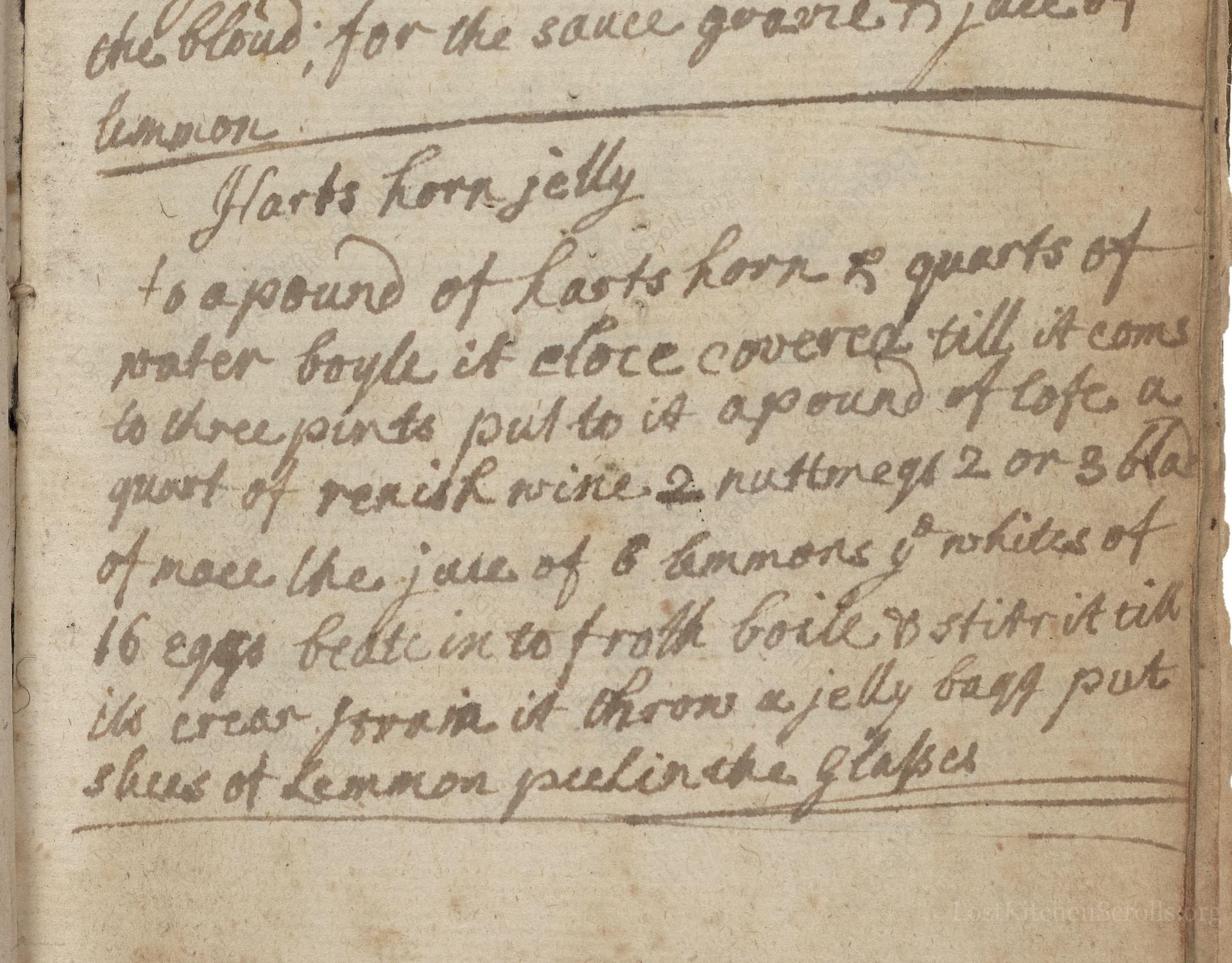Harts Horn Jelly
From the treasured pages of Medicinal and cookery recipes of Mary Baumfylde
Written by Mary Baumfylde

Harts Horn Jelly
"to a pound of Harts horn & quarts of water boyle it close covered till it coms to three pints put to it a pound of suge^r a quart of renish wine 2 nuttmegs 2 or 3 sla[ces] of mace the juce of 8 lemmons & whites of 16 eggs beatt in to froth boile & stire it til its clear strain it thro a jelly bagg put shiees of Lemmon peel in the glasses"
Note on the Original Text
This recipe, like most in 17th-century manuscripts, is written in an abbreviated, imperative style with minimal punctuation or instruction for beginners. Measurements rely on commonly used domestic weights and volumes like 'pound' and 'quart' (equivalent to around 450 g and 950 ml, respectively). Spelling is idiosyncratic (for instance, 'suge^r' for 'sugar,' 'lemon' as 'lemmon'). The recipe assumes the cook knows standard steps like straining, clarifying with egg white, and serving in glasses. The use of a jelly bag and careful clarification would be well-understood among accomplished cooks of the period, aiming for clarity, flavor, and refinement.

Title
Medicinal and cookery recipes of Mary Baumfylde (1626)
You can also click the book image above to peruse the original tome
Writer
Mary Baumfylde
Era
1626
Publisher
Unknown
Background
A sumptuous journey into early 17th-century English cookery, this delightful volume offers a tantalizing glimpse into the recipes, flavors, and culinary secrets that once graced aristocratic tables. Prepare for a taste of history, presented with wit and wisdom!
Kindly made available by
Folger Shakespeare Library
This recipe comes from an English household manuscript originating in the early 17th century when gelatin was extracted by slow boiling bones and animal parts, long before the days of commercial gelatin. Harts horn—literally the antlers of male deer—was prized for its ability to produce a fine, clear jelly, used in both savory and sweet dishes. Such jellies were considered fashionable, nourishing, and even medicinal at the time. The use of egg whites and a jelly bag for clarification was a common technique to achieve the prized, crystal-clear dessert. Mary Baumfylde, the woman linked to this recipe, represents the kind of gentlewoman who compiled extensive culinary manuscripts, blending courtly tastes with practical domestic skills. Recipes like this one circulated among elite English households, cherished for celebratory dinners or restorative suppers.

Much of the work was done using large earthenware or copper pots over a wood fire, with a tightly fitting lid to keep in moisture. A mortar and pestle would be needed to grate the nutmeg and perhaps to grind the sugar if not already powdered. Straining was performed through linen, muslin, or specialty 'jelly bags' suspended over bowls to produce a perfectly clear jelly. Whisks (then called 'birches') were used to beat egg whites to a froth. The finished jelly would be set in clear glass or ceramic 'glasses'—essentially open dishes or small molds—for presentation.
Prep Time
30 mins
Cook Time
2 hrs 30 mins
Servings
12
We've done our best to adapt this historical recipe for modern kitchens, but some details may still need refinement. We warmly welcome feedback from fellow cooks and culinary historians — your insights support the entire community!
Ingredients
- 1 lb hartshorn (or substitute: 2 oz powdered gelatin or equivalent number of gelatin leaves)
- 3 quarts water
- 1 lb sugar
- 1 quart Riesling wine (or another dry white wine)
- 2 whole nutmegs, grated
- 2–3 pieces (about 0.07 oz) mace
- Juice of 8 lemons (approx. 1⅓ cups)
- Whites of 16 eggs (approx. 2 cups)
- Lemon peel, thinly sliced, for garnish
Instructions
- To make a version of Harts Horn Jelly with today’s ingredients, begin with about 1 pound of traditional hartshorn (the antler of a stag, though gelatin sheets or powder may substitute), and cover this with 3 quarts of water.
- Simmer in a tightly covered pot until the liquid is reduced by about 1.25 pints, giving you around 3 pints.
- Strain, then stir in 1 pound sugar, 1 quart Riesling or other mildly sweet white wine, two grated nutmegs, 2–3 pieces of mace, juice from 8 lemons, and the beaten whites of 16 eggs.
- Gently bring all to a simmer, stirring, until the mix is clear.
- Strain the jelly through a fine cloth-lined sieve or a traditional jelly bag.
- Pour into serving glasses with slivers of lemon peel for both garnish and flavor.
Estimated Calories
210 per serving
Cooking Estimates
Preparing Harts Horn Jelly takes some time. You simmer the hartshorn or gelatin with water, then reduce the liquid for about 2 hours. After straining, mixing in the remaining ingredients, and gently simmering again, the jelly is strained and poured into serving glasses. Allow some time for the jelly to fully set before serving. Each serving has about 210 calories, and this recipe makes 12 generous servings.
As noted above, we have made our best effort to translate and adapt this historical recipe for modern kitchens, taking into account ingredients nowadays, cooking techniques, measurements, and so on. However, historical recipes often contain assumptions that require interpretation.
We'd love for anyone to help improve these adaptations. Community contributions are highly welcome. If you have suggestions, corrections, or cooking tips based on your experience with this recipe, please share them below.
Join the Discussion
Rate This Recipe
Dietary Preference
Main Ingredients
Culinary Technique
Occasions

Den Bockfisch In Einer Fleisch Suppen Zu Kochen
This recipe hails from a German manuscript cookbook compiled in 1696, a time whe...

Die Grieß Nudlen Zumachen
This recipe comes from a rather mysterious manuscript cookbook, penned anonymous...

Ein Boudain
This recipe comes from an anonymous German-language manuscript cookbook from 169...

Ein Gesaltzen Citroni
This recipe, dating from 1696, comes from an extensive anonymous German cookbook...
Browse our complete collection of time-honored recipes



